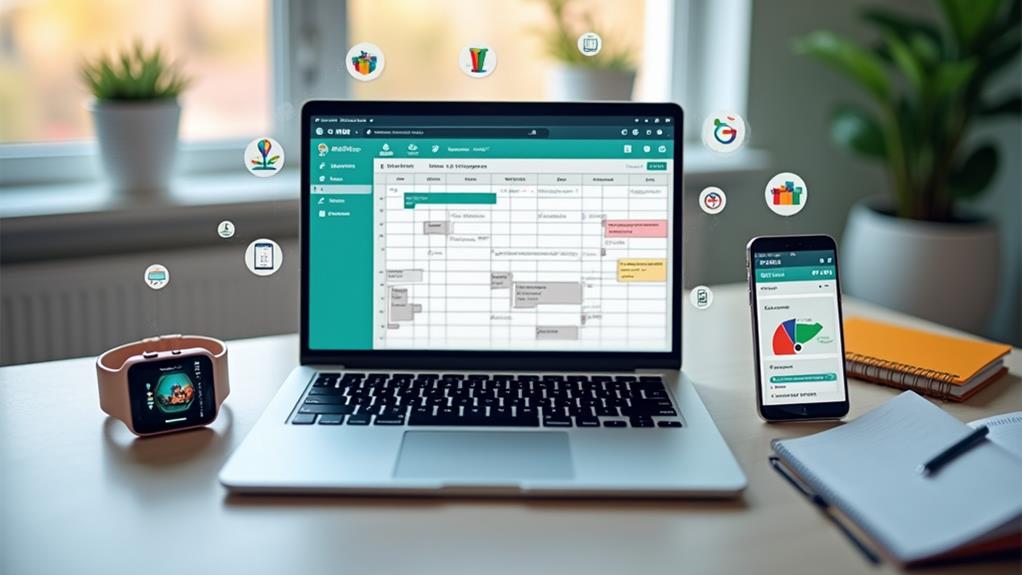
Effective time management is essential for freelancers to maintain productivity and uphold a high standard of work. Create detailed to-do lists and integrate them with calendars for better visual scheduling. Use tools like Clockify for time tracking to identify inefficiencies and maximize productivity. Establish a consistent work schedule with regular breaks to avoid burnout and set clear work boundaries. Prioritize tasks using techniques like the Eisenhower Matrix to focus on high-impact activities. Minimizing distractions with apps like Freedom can substantially improve concentration. Incorporating these strategies seamlessly blends into your workflow, enhancing both efficiency and output. Additionally, managing finances, setting clear goals, and leveraging the right technology can boost productivity further.
Key Takeaways
- Create detailed to-do lists with fewer than ten specific items to enhance focus and productivity.
- Use the Eisenhower Matrix to prioritize tasks by urgency and importance.
- Track your time with tools like Clockify or Toggl to uncover inefficiencies and optimize productivity.
- Set a consistent work schedule with regular breaks to maintain concentration and prevent burnout.
- Eliminate digital distractions by using blocking apps and designating specific times for checking emails and social media.
Importance of Time Management
Effective time management is essential for freelancers as it directly influences their earnings and professional reputation. Poor management can lead to missed deadlines and lost clients, making time allocation a vital skill. Freelancers, often working from home, face numerous distractions that necessitate self-discipline. Effective time allocation guarantees that tasks are completed systematically, reducing the risk of decreased productivity and jeopardizing business sustainability.
Deadline management is another key aspect. Delivering work on time not only fosters strong testimonials but also secures client retention, which is important for long-term success. Structured routines and time-tracking tools can greatly enhance a freelancer's ability to manage time efficiently. These tools provide a clear overview of how time is spent, allowing for adjustments that maximize output.
Additionally, engaging with writing communities can provide valuable insights and support in steering through time management challenges.
Evidence suggests that freelancers who implement disciplined time management practices experience higher productivity levels and improved client relations. By prioritizing tasks and setting realistic deadlines, freelancers can avoid the pitfalls of poor time management. This proactive approach not only safeguards their earnings but also builds a solid professional reputation, ultimately leading to sustained business growth.
Create Effective To-Do Lists
To create effective to-do lists, limit daily tasks to fewer than ten specific items to enhance focus and prevent overwhelm.
Use detailed action steps instead of vague descriptions for clarity, reducing frustration and improving motivation.
Integrate your to-do lists with a calendar to visually schedule tasks, streamlining your workflow and efficiently managing deadlines.
Regularly assess your workload to stay on top of tasks and avoid last-minute scrambles.
This approach guarantees that you have a clear understanding of your daily responsibilities and can adjust priorities as needed.
Prioritize Daily Task Items
Crafting a well-structured to-do list is vital for freelancers aiming to optimize their time management. Effective to-do lists should include fewer than 10 specific tasks daily to enhance manageability and prevent overwhelm.
Prioritizing daily task items through frameworks like the Eisenhower Matrix can greatly boost productivity. This matrix helps in task categorization by distinguishing between urgent and important activities, guaranteeing that high-impact tasks receive the necessary focus.
Regularly performing daily reflections is essential for maintaining an effective to-do list. By reviewing and adjusting your tasks, you can guarantee alignment with evolving priorities and deadlines, thereby enhancing overall productivity. Incorporating deadlines for each task fosters accountability and encourages timely completion.
Here are three actionable steps for prioritizing daily tasks:
- Use the Eisenhower Matrix: Categorize tasks into four quadrants—urgent and important, important but not urgent, urgent but not important, and neither urgent nor important—to allocate your focus effectively.
- Limit Daily Tasks: Aim to list fewer than 10 tasks per day to maintain manageability and prevent feeling overwhelmed.
- Review and Adjust: Conduct daily reflections to review and adjust your to-do list, guaranteeing tasks align with current priorities and deadlines.
Use Detailed Action Steps
Leveraging detailed action steps is essential for creating effective to-do lists that enhance productivity and focus. By crafting concise to-do lists with fewer than 10 specific tasks daily, freelancers can enhance their concentration and prevent overwhelm. Breaking down vague tasks into detailed action items provides clarity and sustains motivation throughout the day.
For instance, instead of listing "work on client project," a more detailed breakdown would include "outline project scope," "draft initial design," and "review feedback." This approach establishes clear milestones, making tasks more manageable and progress more visible.
Prioritizing these tasks using methods such as the Eisenhower Matrix guarantees that the most important and urgent tasks are tackled first, optimizing time management.
Additionally, utilizing digital tools like Todoist or Trello can streamline organization, offering easy tracking of progress and deadlines. These tools support regular reviews and adjustments of to-do lists, allowing freelancers to adapt to changing priorities and maintain workflow momentum.
This continuous evaluation helps in refining action steps to stay aligned with goals.
Integrate Lists With Calendars
Building on the foundation of detailed action steps, integrating to-do lists with calendars greatly enhances time management and accountability for freelancers. By visually scheduling tasks alongside deadlines, freelancers can streamline their workflow and guarantee that no task is overlooked. Tools like Google Calendar and Todoist are particularly effective, as they allow for calendar synchronization, linking specific tasks to designated time slots for increased efficiency.
To maximize the benefits of integrating lists with calendars, consider the following steps:
- Task Visualization: Use calendar apps to create a clear visual representation of your tasks. This aids in understanding workload distribution and identifying potential bottlenecks.
- Prioritization Using the Eisenhower Matrix: Categorize tasks within your calendar by urgency and importance. This helps maintain focus on critical tasks while guaranteeing less urgent activities are not neglected.
- Setting Reminders: Schedule reminders for each task directly in your calendar. This guarantees timely completion and reduces the risk of missing deadlines.
Regularly reviewing and adjusting your integrated lists and calendar is essential. This practice allows freelancers to adapt to changing workloads and maintain a clear focus on priorities, ultimately leading to more efficient and productive work habits.
Track Your Time

Tracking your time is an essential practice for freelancers aiming to enhance their productivity and efficiency. One of the primary time tracking benefits is the ability to pinpoint where your hours are spent, uncovering inefficiencies and enabling you to make strategic adjustments.
Tools like Clockify and Toggl streamline the process, offering features such as project tracking and detailed reporting to analyze your productivity levels effectively. Furthermore, it is vital to regularly assess activities to eliminate time-wasting behaviors.
Implementing time audit techniques involves regularly reviewing your time logs to identify patterns, such as peak productivity periods. This data-driven approach allows you to optimize your working hours to align with your most productive times, thereby maximizing output.
Additionally, tracking your time provides critical insights into project profitability, ensuring that your pricing reflects the true effort involved.
Consistent time tracking also fosters better accountability and discipline. By maintaining a detailed log of your activities, you enhance your overall time management skills, which is essential for long-term success as a freelancer.
When fully integrated into your workflow, these practices lead to improved efficiency, higher profitability, and a more structured approach to managing your freelance projects.
Set a Work Schedule
Set a Work Schedule
After effectively tracking your time, the next step in optimizing your freelance workflow is to set a structured work schedule. Establishing consistent work hours is vital for maintaining productivity and creating a clear boundary between professional and personal life.
Part-time roles provide flexibility for career and personal priorities, contributing to an overall fulfilling work-life balance. Here are actionable steps to implement a well-defined work schedule:
- Set Consistent Start Times: Begin your workday at the same time each morning to train your brain to recognize work periods. This routine enhances focus and reduces procrastination, mimicking the discipline of a traditional office environment.
- Schedule Breaks: Integrate regular breaks, including a lunch hour, into your workday. These intervals are important for maintaining high levels of concentration and preventing burnout. A well-rested mind is more productive and creative.
- Client Communication: Clearly communicate your work hours to clients. This practice fosters respect for your time and helps manage their expectations regarding availability and response times. Effective client communication guarantees that you can work without unnecessary interruptions.
Eliminate Distractions

Eliminate Distractions
Eliminating distractions is essential for freelancers aiming to maximize productivity.
Begin by managing digital interruptions through strategies such as turning off notifications and using apps like Freedom or Cold Turkey to block distracting websites.
Additionally, establish a dedicated workspace that minimizes interruptions and clearly signals to others that you are in work mode.
Incorporate regular screen breaks to prevent burnout and refresh the mind.
Setting clear boundaries between work and personal time can greatly enhance focus and overall efficiency.
Manage Digital Interruptions
In today's digital age, interruptions from social media and notifications can greatly hamper a freelancer's productivity, consuming up to 28% of the workday.
Implementing a digital detox is essential for maintaining focus and enhancing efficiency. Here are three actionable productivity hacks to manage digital interruptions effectively:
- Use Blocking Apps: Leveraging apps like Freedom or Cold Turkey can help block distracting websites and notifications during designated work hours. By limiting access to social media and other distractions, freelancers can create uninterrupted work periods, thereby boosting productivity.
- Schedule Specific Times for Digital Engagement: Setting designated times for checking emails and social media can greatly reduce the frequency of digital interruptions. Research indicates it takes an average of 23 minutes to regain focus after a distraction, underscoring the importance of having controlled, scheduled engagement periods.
- Implement a Digital Detox Routine: Regularly practicing digital detox techniques, such as turning off non-essential notifications and setting device-free hours, can mitigate the constant influx of digital disruptions.
This approach not only aids in maintaining concentration but also promotes a healthier work-life balance.
Designated Workspaces
A well-defined workspace is vital for freelancers aiming to maximize productivity and minimize distractions. Creating a designated personal workspace helps establish a clear boundary between work and personal life, enhancing focus and productivity by reducing interruptions.
Workspace organization is important; research indicates that a clutter-free and organized productivity environment can improve cognitive function and decrease stress, leading to increased efficiency.
To further enhance focus, consider utilizing noise-cancelling headphones within your workspace boundaries to block out ambient noise. This simple addition to your creative workspace can greatly improve concentration on tasks.
Workspace personalization is another effective strategy. Adding elements like inspiring quotes or plants can transform your workspace into a motivational workspace, boosting your mood and productivity.
Break Down Projects
Breaking down larger projects into smaller, manageable tasks is a proven strategy to reduce overwhelm and enhance clarity on deliverables. Task decomposition and project segmentation make even the most intimidating tasks approachable. This approach involves dissecting a project into smaller, actionable steps, thereby increasing focus and productivity. By defining your niche, you can better align these smaller tasks with your target audience's needs, ensuring your efforts are both efficient and effective.
- Facilitate Scheduling: Project segmentation allows for efficient time management. Smaller tasks can be allocated specific time blocks in your calendar, optimizing your workflow and ensuring consistent progress.
- Enhance Motivation: Regularly evaluating progress on smaller tasks offers a sense of achievement. This motivates freelancers and provides clarity on the overall project's trajectory, making it easier to stay on track.
- Minimize Context Switching: Grouping similar tasks together (batch work) minimizes context switching, which can greatly enhance productivity. Focusing on one type of task at a time streamlines the workflow and reduces cognitive load.
Incorporating techniques such as the Rule of 52 and 17, where you work for 52 minutes followed by a 17-minute break, can also help maintain focus on individual components.
Use Productivity Techniques

Effective time management for freelancers hinges on the strategic use of productivity techniques. The Pomodoro Technique, which involves working for 25 minutes followed by a 5-minute break, has been shown to enhance focus and reduce the likelihood of burnout. This method is particularly useful for freelancers juggling multiple tasks.
Additionally, research demands can be accounted for within these productivity blocks, guaranteeing that the necessary preparatory work is completed efficiently.
Another effective approach is the Eisenhower Matrix, which helps prioritize tasks by categorizing them into four quadrants based on urgency and importance. This task categorization aids in better decision-making, assuring that high-priority, high-impact tasks are tackled first.
Implementing the Getting Things Done (GTD) method further enhances productivity by breaking down tasks into actionable items. This systematic approach provides clear steps to achieve larger goals, making the workflow more manageable and efficient.
Regularly reviewing and adjusting these techniques is essential; adaptability strategies guarantee that freelancers find the most effective methods that align with their individual workflows.
Experimenting with productivity tools such as Trello for visual management and Toggl for time-tracking can also streamline processes and boost efficiency.
These evidence-based techniques collectively contribute to focus enhancement and burnout reduction, ultimately leading to more productive freelancing.
Network and Collaborate
Mastering productivity techniques is just one aspect of successful freelancing; building a robust network and collaborating strategically is equally essential for long-term success.
Networking can lead to new projects and collaborations, enhancing a freelancer's visibility and client base within their industry. For instance, engaging with food bloggers and influencers can markedly expand creative opportunities and client reach.
Engaging with other freelancers through social media and professional communities provides valuable support and shared resources, boosting overall productivity.
Here are three actionable steps to enhance your networking strategies and collaboration efforts:
- Leverage Professional Platforms: Utilize LinkedIn and freelance-specific networks to build a professional presence. These platforms are invaluable for fostering relationships that may lead to future work and collaborations.
- Attend Industry Events: Both virtual and in-person events offer opportunities to connect with potential clients and collaborators. Such interactions can lead to partnerships and referrals that are essential for business growth.
- Use Collaboration Tools: Tools like Trello, Slack, and Asana can streamline project management when working with other freelancers. These tools help diversify skill sets and enhance the quality and efficiency of deliverables.
Implementing these networking strategies and utilizing effective collaboration tools can markedly contribute to a freelancer's productivity and market competitiveness.
Develop Skills Continuously

To remain competitive, freelancers should regularly engage with online learning platforms like Coursera and Udemy to stay updated on industry trends and acquire new skills.
Allocating specific time each week for skill assessments and professional development can greatly enhance expertise and income potential.
Additionally, staying aware of current industry trends guarantees that freelancers can adapt quickly to market demands and maintain their relevance.
Leveraging these platforms for continuous learning will help develop essential skills like SEO, content creation, and social media strategies, enabling freelancers to offer a diverse range of services and stay ahead in the market.
Online Learning Platforms
Freelancers' ability to stay competitive hinges on the continuous development of their skills, and online learning platforms like Coursera, Udemy, and LinkedIn Learning provide an invaluable resource for this purpose.
These platforms offer a vast array of courses across various fields, allowing freelancers to enhance their capabilities and meet market demands. To maximize the benefits, freelancers should adopt effective learning strategies and seek out course recommendations that align with their professional goals.
Here are three key points to reflect on:
- Cost-Effective Learning: Many online learning platforms offer free or low-cost courses, making professional development accessible. Additionally, certifications upon course completion can bolster a freelancer's credentials and credibility.
- Flexibility and Convenience: Online learning allows freelancers to study at their own pace and schedule, which is particularly beneficial for balancing work commitments with skill enhancement.
- Up-to-Date Content: Platforms frequently update their course offerings to include the latest industry trends and technologies, ensuring freelancers acquire relevant and current skills.
Incorporating these insights can help freelancers stay productive and competitive in an ever-evolving job market.
Continuous learning not only improves skill sets but also opens new opportunities for career growth.
Industry Trends Awareness
Keeping abreast of industry trends is vital for freelancers to maintain a competitive edge and meet the dynamic needs of clients. Staying informed about these trends allows freelancers to adapt their skills according to evolving market demands, enhancing their marketability. Utilizing freelance resources such as online courses, webinars, and workshops can considerably contribute to continuous skill development.
Freelancers should regularly conduct market analysis to identify emerging trends and technologies. Engaging in professional communities and networking groups can also provide valuable insights and collaborative opportunities for skill enhancement. Additionally, seeking client feedback about industry trends can pinpoint specific areas for improvement, guaranteeing alignment with market needs.
| Method | Benefit |
|---|---|
| Online Courses | Enhances skill sets |
| Webinars | Provides up-to-date knowledge |
| Workshops | Offers hands-on experience |
| Client Feedback | Identifies market requirements |
| Networking Groups | Shares industry insights |
Allocating dedicated time each week for personal and professional growth is essential. This practice guarantees freelancers stay current with technological advancements and best practices in their field. By leveraging these freelance resources and engaging in regular market analysis, freelancers can continuously develop their skills, positioning themselves as valuable assets to clients and the broader marketplace.
Weekly Skill Assessments
Staying updated on industry trends is only part of the equation for maintaining a competitive edge. Conducting weekly skill assessments enables freelancers to identify their strengths and weaknesses, facilitating targeted improvement. By setting aside time each week for freelancer self-assessment and seeking client feedback, freelancers can adapt to changing industry demands and remain competitive.
Here are three effective skill enhancement strategies for freelancers:
- Online Courses and Workshops: Incorporate relevant online courses or workshops into your weekly schedule to facilitate continuous learning and acquire new skills. This not only enhances your marketability but also keeps you aligned with current industry standards.
- Skills Journal: Maintain a skills journal to document progress and challenges. This practice provides valuable insights, helps track your development over time, and keeps you motivated to stay committed to your professional growth.
- Regular Reassessments: Regularly reassess your skills to verify they align with current market trends. This proactive approach allows you to pivot and seize new opportunities as they arise, verifying long-term success in the freelancing landscape.
Implementing these strategies can markedly boost a freelancer's ability to stay productive and maintain a competitive edge in an ever-evolving market.
Maintain Work-Life Balance
Maintaining a healthy work-life balance is vital for freelancers to avoid burnout and sustain mental well-being. Boundary setting between work and personal time is important. Establishing a dedicated workspace can enhance focus and minimize distractions, contributing to overall productivity. Regularly scheduling downtime and personal activities can greatly improve well-being, with freelancers who prioritize self-care reporting higher satisfaction and efficiency.
To further support work-life balance, engaging in hobbies outside of freelancing is beneficial. These activities not only promote relaxation but also foster creativity and improve problem-solving skills. Regularly evaluating your workload is another important strategy. Freelancers who meticulously track their hours and tasks can better prevent overwhelm and guarantee they get adequate rest.
Effective communication of your work hours to friends and family is vital for maintaining respect for your personal time. This fosters a supportive environment where boundaries are acknowledged and upheld, essential for a sustainable freelance career.
| Strategy | Benefit | Implementation Tip |
|---|---|---|
| Boundary Setting | Prevents burnout | Create a dedicated workspace |
| Scheduling Downtime | Enhances well-being | Block personal activities in your calendar |
| Engaging in Hobbies | Fosters creativity | Set aside time weekly for hobbies |
| Evaluating Workload | Prevents overwhelm | Track hours and tasks regularly |
| Communicating Work Hours | Sustains personal time | Inform family of your work schedule |
Manage Finances and Clients

Effectively managing finances and clients is essential for freelancers to sustain long-term success and stability. Budget planning is a cornerstone of financial stability, requiring consideration of monthly expenses, tax savings, and irregular income.
Utilizing accounting software like QuickBooks or FreshBooks can streamline invoicing, expense tracking, and tax preparation, fostering accuracy and efficiency. Freelancers must also be mindful of self-employment tax obligations, including both halves of Social Security and Medicare taxes, totaling 15.3%.
To guarantee timely compensation and prevent misunderstandings, freelancers should establish clear client contracts outlining payment terms, deliverables, and deadlines. This not only safeguards income but also sets professional expectations from the outset.
Regular income assessment helps maintain a balance between workload and earnings, preventing burnout and promoting sustainable business growth.
Effective communication strategies are also critical. Open discussions with clients regarding project timelines and availability foster trust and can lead to repeat business and referrals.
Here are three actionable steps:
- Budget Planning: Establish a detailed budget that includes monthly expenses and tax savings.
- Client Contracts: Draft thorough contracts to clarify payment terms and project deliverables.
- Expense Tracking: Use reliable accounting software to monitor expenses and prepare for taxes.
Set Clear Goals
Although freelancers often enjoy the flexibility to set their own schedules, establishing clear and achievable goals is imperative for maintaining productivity and focus. Implementing the SMART criteria—Specific, Measurable, Achievable, Relevant, and Time-bound—can greatly enhance a freelancer's motivation and direction.
Goal visualization, where freelancers imagine the successful completion of their tasks, can further clarify these objectives and boost determination.
Breaking down larger projects into smaller, manageable tasks helps mitigate feelings of overwhelm and provides a clear path to completion. This segmented approach not only makes the workload more approachable but also fosters a sense of accomplishment as each task is completed.
Utilizing tools like Trello or Asana for tracking goals and progress can streamline workflow and guarantee freelancers remain accountable to their objectives.
Regularly revisiting and adjusting goals guarantees they align with current priorities, allowing freelancers to adapt to changing workloads and maintain productivity.
Additionally, celebrating small wins along the way boosts morale and reinforces a positive mindset towards achieving larger goals. Engaging accountability partners can also provide external motivation and support, further enhancing the effectiveness of goal-setting strategies.
Leverage Technology

Leveraging technology can greatly enhance a freelancer's time management by automating repetitive tasks with tools like Zapier, potentially saving an average of 10 hours per month.
Utilizing time-tracking apps such as Toggl or Clockify helps identify inefficiencies and optimize productivity by revealing trends in time allocation.
Additionally, embracing digital project management platforms like Asana or Trello can improve task organization and collaboration, increasing on-time delivery rates by 25%.
Automate Repetitive Tasks
In today's fast-paced freelance environment, automating repetitive tasks is crucial for maximizing productivity and efficiency. Through effective workflow analysis and task delegation, freelancers can considerably reduce time spent on monotonous activities.
Here are three actionable strategies to leverage technology for automating tasks:
- Utilize Automation Tools: Platforms like Zapier allow freelancers to connect different apps, automating tasks such as data entry and email responses. This streamlining can free up valuable time for more critical work.
- Implement Invoicing Software: Tools such as FreshBooks or QuickBooks can automate expense tracking and report generation, particularly beneficial during tax season. This reduces administrative overhead, enabling freelancers to focus on core activities.
- Adopt Email Automation: Services like Mailchimp facilitate the scheduling and bulk sending of marketing emails, minimizing the time spent on individual client communications. This guarantees consistent and efficient client outreach.
Additionally, using templates for common documents and communications can enhance efficiency and consistency.
Task automation tools like IFTTT (If This Then That) can manage social media posts by automatically sharing new content across platforms, eliminating manual effort.
Utilize Time-Tracking Apps
Building on the productivity gains from automating repetitive tasks, freelancers can further optimize their efficiency by utilizing time-tracking apps. Tools like Clockify and Toggl enable freelancers to monitor hours spent on various tasks, providing valuable productivity insights and enhancing project profitability.
By leveraging time tracking benefits, freelancers can gain a detailed understanding of where their time is going, which is essential for effective time management and prioritization.
These apps often feature project tracking, reporting, and integration with project management software, aiding in streamlining workflows and increasing overall efficiency. Regular use of time-tracking tools can uncover inefficiencies, allowing freelancers to make informed adjustments to their schedules and improve their productivity.
Moreover, many time-tracking apps offer mobile versions, enabling freelancers to log hours and analyze productivity on-the-go. This guarantees consistent tracking regardless of location, which is particularly beneficial for freelancers who work from various environments.
Utilizing time-tracking technology also greatly improves billing accuracy, allowing freelancers to charge clients based on actual hours worked. This not only enhances transparency but can also lead to increased income, as accurate billing guarantees that no billable hours are overlooked.
Optimize Workflows Efficiently
Harnessing the power of technology, freelancers can greatly optimize their workflows and boost productivity. By leveraging workflow automation and task delegation, freelancers can streamline their processes and focus on core tasks.
1. Workflow Automation: Utilize automation tools like Zapier to connect different apps, enabling seamless data transfer and reducing repetitive tasks. This not only saves time but also improves overall efficiency.
For instance, automating the transfer of data from emails to project management software can cut down manual entry and minimize errors.
2. Task Delegation and Management: Implement project management software such as Asana or ClickUp. These platforms allow freelancers to organize tasks, set deadlines, and monitor progress, fostering accountability and collaboration.
By delegating tasks through these tools, freelancers can guarantee that all project elements are tracked and managed effectively, improving productivity.
3. Time-Tracking and Scheduling: Leverage time-tracking tools like Clockify or Toggl to gain thorough insights into how time is allocated across various tasks. This data supports better scheduling and resource allocation.
Additionally, using digital calendars such as Google Calendar for time-blocking helps visualize daily schedules and prioritize high-impact tasks effectively.
Incorporating these technologies into daily routines can greatly enhance a freelancer's ability to manage time and tasks efficiently.
Establish a Routine
With a consistent start time each day, freelancers can greatly enhance productivity by training their brains to recognize designated work periods and reduce procrastination.
Starting the day with morning rituals such as planning tasks and setting goals can establish a productive mindset. Evening reviews are equally important as they allow for reflection on the day's accomplishments and help to plan for the next day, ensuring continuous improvement.
Incorporating scheduled breaks into your routine is essential for maintaining mental clarity. Regular downtime can refresh the mind, leading to increased focus and creativity when you return to work.
This practice mimics the structured environment of a traditional office, promoting discipline and helping maintain clear boundaries between work and personal life.
Flexibility within your routine is vital to accommodate personal commitments, ensuring a balanced lifestyle. This balance is key to sustaining long-term productivity without burnout.
Additionally, communicating your established work hours to clients fosters respect for your time and sets clear expectations for project timelines and responses.
Frequently Asked Questions
How to Manage Time Effectively as a Freelancer?
To manage time effectively as a freelancer, implement effective scheduling strategies by setting specific work hours. Utilize task prioritization techniques like the Eisenhower Matrix and the Pomodoro Technique to enhance productivity and maintain focus.
How to Stay Productive as a Freelancer?
To stay productive as a freelancer, establish clear goal setting practices and leverage productivity tools like Toggl or Clockify. Utilize structured routines, break tasks into manageable parts, and minimize distractions to maintain a focused, high-efficiency workflow.
How Many Hours a Day Should a Freelancer Work?
Freelancers should aim for ideal work hours of 5 to 6 hours per day to maximize productivity and prevent freelance burnout, utilizing techniques like the Pomodoro Technique to structure focused work sessions and guarantee regular breaks.
How Can a Freelancer Work Full Time?
To work full-time as a freelancer, establish a consistent schedule, utilize time-tracking tools, and break down projects. Prioritize client communication and maintain work-life balance through regular breaks and self-care to sustain long-term productivity.
Conclusion
Effective time management is essential for freelancers to maintain productivity and achieve professional goals. By creating structured to-do lists, tracking time, setting work schedules, and eliminating distractions, freelancers can optimize their workflow. Additionally, managing finances and clients, setting clear goals, leveraging technology, and establishing a routine contribute to sustained efficiency. Adopting these evidence-based strategies guarantees that freelancers can navigate the challenges of independent work while maximizing output and maintaining a balanced professional life.
Leave a Reply